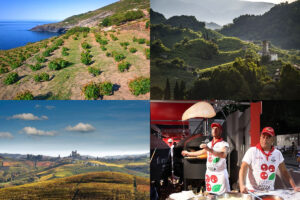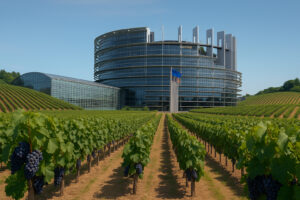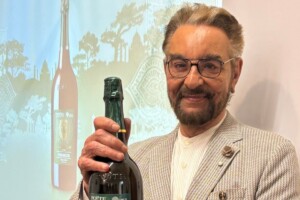One of the most famous Italian wine producers, Angelo Gaja, makes his “Case for Brunello di Montalcino”…
In the sixties, the vineyards of Sangiovese that were used to produce Brunello di Montalcino barely reached 60 hectares, there were about 20 producers, the bottles that were produced were no more than 150,000; during the same period, hectares planted with Nebbiolo in the Barolo area were 500, 115 producers/bottlers, and 3,000,000 bottles of Barolo produced per year.
While, however, Barolo did not have a leader, Brunello di Montalcino already had one with its founding father, Biondi Santi, the artisan who, over time, had kept the banner high for the quality and the price of an aristocratic, rare, precious Brunello that was accessible to the very few who could afford it.
Then Banfi arrived. And to understand how the Brunello di Montalcino phenomenon exploded, Biondi Santi and Banfi cannot be left unconsidered.
Banfi, which is property of the American wine distributing brothers Mariani, ignited the “American Dream” for the red wine from Montalcino: the future is yours, friend, grow and multiply.
The adventure began with a series of clamorous errors. With the go-ahead from the local administration and the agricultural unions, the areas dedicated to the vineyards were literally overturned: secular forests and oaks were upturned, hills flattened by tens of meters; with the help of a few gurus of viticulture, cultural techniques were introduced that were poles apart from the accurate cultivation of the vine; rather than planting Sangiovese to produce Brunello di Montalcino, 500 hectares of Moscadello were planted to produce a type of white Lambrusco that would not lead to success. The enterprise seemed to be headed towards total failure.
And, instead, a miracle, after its initial confusion, Banfi takes note of the errors committed, tempestively converts the vineyards, aims with great confidence towards the production of Brunello di Montalcino and becomes the leading engine of the denomination on the U.S. market, the most important world wide for fine wines, a demand that would soon fall on the unaware producers of Montalcino, then spreading around the world.
No other Italian DOCG has the fortune of having an historic leader and a market leader like Brunello di Montalcino has. Thanks to them the interest grew among Italian and foreign producers/investors, who came to attempt to create enterprises in Montalcino thus helping consolidate the extraordinary push for growth and to assert the denomination on international markets.
Today, the hectares of Nebbiolo are 1,800, while those for Sangiovese that are recognized as eligible for the production of Brunello have reached 2,000 hectares – and, yes, producers have looked to slow down the rush by introducing the blocking of new structures – 250 producers and 7 million bottles produced each year.
It has been made note of by many observers that the majority of the new vineyards do possess the climatic characteristics that can ensure the Sangiovese grape will express a wine of excellence and there have been complaints of the lack of zoning (the scientific cataloguing of the terrains with the delineation of those that have the vocation and those that don’t): but zoning in no other part of the world – apart from maybe Burgundy, which recognizes not just one but over 100 different denominations of origin – has become the inspiring principle for production disciplines. Even less so in Italy, where there is more inclination to cultivate solidarity and kindness.
Today, in Montalcino, there is a minority of producers who enjoy a double privilege: of having vineyards that are registered as well possessing Sangiovese vineyards that are capable of expressing excellent wines. And then there is the majority of producers who enjoy only the first privilege. Consumers expect from both a Brunello of elevated quality.
The production disciplinary, written in the sixties, when there were still only about sixty hectares that were registered, imposes 100% Sangiovese for the production of Brunello di Montalcino. With the explosion of vineyard areas, the majority of producers who owned vineyards of dubious quality felt the need to improve the quality of their wines and it appeared most evident that the imposition of 100% Sangiovese grapes was penalizing. It was thought that the genetic improvement of Sangiovese through clone selections and the introduction of new technologies in vineyards and wineries would have changed the situation, while, instead, the question is still on the table just as it was then.
If the investigations that the magistrature are conducting ascertain the use of different varieties from that of Sangiovese for the production of Brunello di Montalcino, the most serious offence committed by producers would be that of not having taken action beforehand to modify the production discipline and remove the obligation of 100% Sangiovese. I remind you that the Rosso di Montalcino discipline is even more inadequate, presumptuous, and out of date.
The production discipline can be modified and the task must be done exclusively by producers.
The obstacle in blocking this is, as always, the conflict between artisan producers and large scale producers, inspired by different production and sales strategies. However, if one looks at the outstanding success of Brunello di Montalcino, it must be recognized that it was created through a synergy between the two, that both were precious in obtaining and consolidating it.
I have read that is considered inappropriate now an intervening act to modify the production discipline for Brunello di Montalcino while the magistrature’s investigation is underway.
In my opinion, the moment has, instead, arrived to think seriously of afterwards, starting with the modification of the discipline; this requires courage, tolerance and reciprocal respect by producers. It means finding a formula that allows artisans to express in their wines the extraordinary dignity of Sangiovese and to be able to declare it on labels so their faithfulness to the 100% variety is recognizable, and for large scale producers to operate with greater elasticity: and both wines must be able to bear the name of Brunello di Montalcino.
Angelo Gaja
Copyright © 2000/2025
Contatti: info@winenews.it
Seguici anche su Twitter: @WineNewsIt
Seguici anche su Facebook: @winenewsit
Questo articolo è tratto dall'archivio di WineNews - Tutti i diritti riservati - Copyright © 2000/2025








































































































































































































